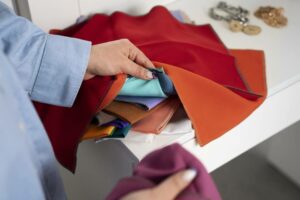Reupholstering furniture is more than just a facelift for your cherished chairs and sofas.
It is a rewarding endeavour that allows you to breathe new life into worn-out pieces, transforming them into stylish and personalised creations.
Continue reading to learn about reupholstering and explore what it means to give your furniture a second life.
What is Reupholstering Furniture?
Reupholstering furniture is not just about updating a furniture’s exterior; it’s a comprehensive makeover involving the replacement of fabric, padding, and possibly springs.
This meticulous process rejuvenates old, worn, or damaged pieces, infusing them with a new spirit and extending their lifespan.
Imagine taking a beloved but battered sofa and transforming it into a piece that looks and feels brand new yet retains its original charm and character.
What are the Benefits of Reupholstering Furniture

1. Environmental Sustainability
In a world increasingly concerned with sustainability, reupholstering furniture is an eco-friendly choice.
By giving new life to existing pieces, we significantly reduce waste, minimising the need for new resources and decreasing our carbon footprint.
2. Customisation
One of the most exciting aspects of reupholstering furniture is the freedom it offers.
From selecting the perfect fabric to choosing patterns and textures, reupholstering allows you to tailor your furniture to match your style and décor preferences.
3. Contribution to a Sustainable Lifestyle
Beyond the aesthetic and practical benefits, taking on a reupholstering project aligns with a broader commitment to a sustainable lifestyle.
It’s a choice that echoes the principles of mindful consumption, encouraging us to value quality and longevity over disposability.
Read More: Why is Fabric Colour Important in Interior Space Design
When to Consider Reupholstering Your Furniture

Here are some key factors to help you determine if reupholstering is the right choice for your furniture:
1. Structural Soundness
At the forefront of this decision-making process is the structural condition of the furniture. A piece that stands firm and free from foundational issues, presents an ideal candidate for reupholstering.
2. Sentimental Value
Often, the pieces most worth reupholstering are those with personal significance. Reupholstering these pieces preserves their presence in your life, allowing them to continue telling their stories.
3. Unique Features
Furniture with unique or irreplaceable characteristics, such as antique detailing, custom craftsmanship, or rare design, is especially suitable for reupholstering.
These features add value and distinction, making reupholstering the furniture worthwhile.
4. Quality and Investment
Consider the quality of the original piece and the potential return on investment. High-quality frames, especially those made from solid wood, are typically worth the effort.
Evaluate how much you’re willing to invest in the project, not just financially but also in time and energy.
Read More: Upholstery Protection: Safeguarding against Wear and Fading
What are the Costs Involved in Reupholstering Furniture

The costs associated with reupholstering furniture can cover a broad spectrum, depending on various factors such as the materials required and the complexity of the task.
Expenses might include the purchase of fabric, padding, and other supplies, as well as potential professional upholstering services, if the project’s scope is beyond a DIY approach.
Opting to reupholster furniture yourself can help manage costs, making the project more accessible.
However, it’s essential to view these expenses as an investment in a beloved piece of furniture, rejuvenating it for continued use and enjoyment.
How to Reupholster Furniture

1. What You Need
To start, gather your tools and materials. Essential items include a staple gun, upholstery fabric, scissors, and a measuring tape.
You might also need foam padding, thread, and upholstery tacks or nails, depending on the specific requirements of your furniture piece.
2. Steps
A. Choose the Right Fabric
Consider materials like cotton, wool, or synthetic blends that offer resilience and beauty. The chosen fabric will significantly influence the overall look and feel of the finished piece.
B. Disassemble and Remove the Old Fabric
Begin by carefully removing the old fabric, which can serve as a template for cutting your new material.
Take care during this process to avoid damaging the furniture’s frame or any internal components such as springs.
C. Prepare the Furniture Frame
With the old fabric removed, clean the frame thoroughly and repair any broken or damaged areas.
This is also the perfect time to consider painting or staining the frame for a completely refreshed look.
D. Measure and Cut the New Fabric
Using the old fabric as a guide, measure and cut your new material. Accuracy is key here, as precise cuts ensure a clean, professional-looking finish.
E. Attach the New Fabric
Secure the new fabric to the frame with either a staple gun or by sewing, depending on your furniture’s design and your personal preference.
Ensure that the fabric is evenly aligned and smooth across the furniture’s surface.
F. Add the Finishing Touches
Personalise your piece with finishing touches like buttons, trims, or piping. These details can add character and flair to your reupholstered furniture.
G. Final Inspection
Before declaring the project complete, check for any loose threads, fabric misalignment, or other minor issues that need correction.
Once everything is in order, your reupholstered furniture is ready to be enjoyed again.
By following these steps, you can transform an old or worn piece into something beautiful and functional, adding a personal touch to your home’s decor.
Read More: Upholstery in Interior Design: Elevating Spaces & More
Get Quality Fabrics for Reupholstering Furniture with Kintex
In conclusion, reupholstering furniture is not just a means to refresh a tired piece; it’s an opportunity to infuse new life, personality, and style into your space.
Explore Kintex’s wide range of upholstery fabrics for home furniture as well as furniture accessories to complement your newly reupholstered item.







